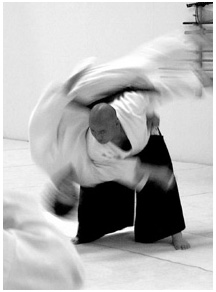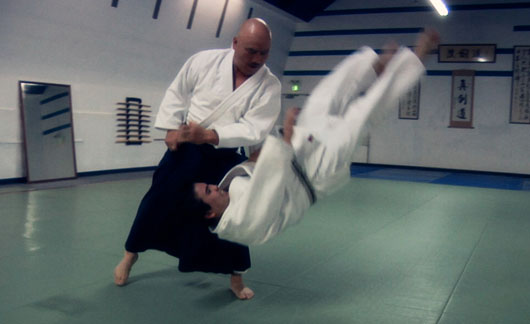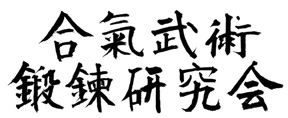.jpg)
Aikidō & Aikibujutsu: The Way of Harmonizing Energy
Aikidō (合気道) and Aikibujutsu (合気武術) are empty-handed arts in which one utilizes, rather than opposes, the energy or force of an opponent's attack through techniques such as throws and controls. Aikidō and aikibujutsu methods do not rely on the use of force against force, but instead involve blending with the opponent's energy and redirecting or diffusing it, resulting in a less destructive (and less effortful) method of overcoming an enemy.These arts also incorporate a study of human anatomy, and take advantage of joints, balance, pressure points and nerve meridians, and other natural vulnerabilities of the body in order to equip one to overcomeeven a much stronger enemy. Such methods are employed by law enforcement agencies around the world, as effective use of aiki methods can facilitate the de-escalation of violence and the arrest of criminalswhile inflicting the least amount of bodily injury.
 The concept of aiki (合気) is generally understood as the confluence or harmonizing of ki (気; vital energy) between two persons, such as an attacker and a defenderin a combative context.Aikidō can be translated as "the way of harmonizing ki"; aikibujutsu can be translated as "martial methods and techniques of harmonizing ki."Aiki is manifested in martial arts practice as the blending of opposing movements and energies; using aiki methods, a skilled practitioner can harness, control, and subdue these energies as needed. Aiki instruction incorporates extensive taisabaki (体捌き; body movement), ashisabaki (足捌き; footwork), as well as kumite (組手; paired exercises), jiyūwaza (自由技; free sparring against single or multiple opponents), and a diversified curriculum of effective techniques.
The concept of aiki (合気) is generally understood as the confluence or harmonizing of ki (気; vital energy) between two persons, such as an attacker and a defenderin a combative context.Aikidō can be translated as "the way of harmonizing ki"; aikibujutsu can be translated as "martial methods and techniques of harmonizing ki."Aiki is manifested in martial arts practice as the blending of opposing movements and energies; using aiki methods, a skilled practitioner can harness, control, and subdue these energies as needed. Aiki instruction incorporates extensive taisabaki (体捌き; body movement), ashisabaki (足捌き; footwork), as well as kumite (組手; paired exercises), jiyūwaza (自由技; free sparring against single or multiple opponents), and a diversified curriculum of effective techniques.
In addition to the aikidō and aikibujutsu curricula, students are taught torite (捕手; arresting techniques), police methods of subduing and arresting criminals through minimal force and injury, as well as Edo-era torimonojutsu (捕物術), arresting techniques practiced in feudal Japan. Supplemental teachings also include tantōjutsu (短刀術; knife technique), bōjutsu (棒術; long staff technique), jō-kumite (杖組手; short staff practice), te-hodoki (手解; unbinding methods), and various other disciplines.

Renowned martial artist Obata Toshishiro-sōshihan, uchi-deshi (内弟子; live-in disciple) under the late Shioda Gōzō-kanchō, relocated from Japan to America in 1980 and began development of a research organization, the Aikidō & Aikibujutsu Tanren Kenkyūkai (合気武術鍛錬研究会; Aiki-Buken for short). The purpose of this organization has been to accurately rebuild concepts and techniques from the older styles of aikibujutsu used during the feudal era in Japan, as well as to study and continue to develop the “softer” styles of modern aikidō.

Aikidō & Aikibujutsu Tanren Kenkyūkai can be translated as "Applied Aiki-Based Martial Systems Research Organization." Aikidō refers to the modern methods as popularized by Ueshiba Morihei, while aikibujutsu refers to the older styles of budō (武道; martial arts) used by the samurai. Tanren (鍛錬) is the process during the forging of a sword in which the blade is hammered and folded, reducing the carbon content and eliminating impurities to create a strong foundation for the remaining steps of forging. Kenkyūkai (研究会) denotes a research organization or society. Being a research organization, the Aiki-Buken has incorporated methods and theories found in both pre- and post-war aikidō/aikijutsu systems that were deemed as useful. Although there is a Yoshinkan Aikidō influence, the approach to training and application differs significantly from this root art.
Practitioners of aikidō and aikibujutsu will learn core principles of movement, defense against various attacks, a multitude of methods for subduing opponents, all elaborated in a rich, cohesive system of strong, practical, and effective technique. When learned throughly, the system of aikidō and aikibujutsu makes available countless variations of aiki techniques and methods,such that a practitioner will be able to freely apply techniques and adapt to the changing circumstances of a given situation.High-level aikidō and aikibujutsu skill is manifested in the ability to control, pin, throw, or otherwise subdue an opponent nearly effortlessly.
